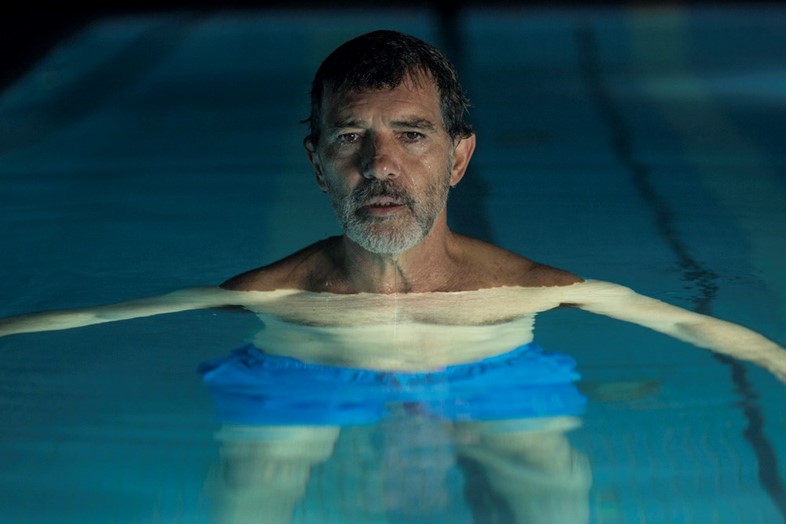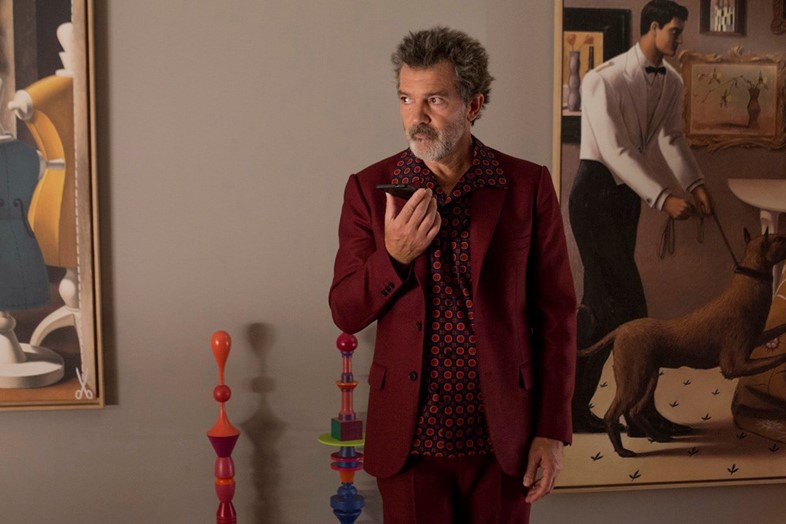Today marks the anticipated arrival of Pedro Almodóvar’s Pain and Glory to UK cinemas, a must-see for these five reasons
- TextDaisy Woodward
The arrival of a new Pedro Almodóvar film is always interesting. The director has a wide-ranging gamut of styles and genres from which he likes to draw, whether sending shivers down our spines with unimaginably cruel tales of revenge (à la The Skin I Live in), presenting us with campy, rollicking comedies (like the raucous airplane drama, I’m So Excited) or poignant depictions of regret and pain, seen through the lens of a character looking back (Julieta). Pain and Glory falls into the latter category, but does so in new, deeply personal ways.
It is the tale of a depressed, ailment-riddled director, named Salvador Mallo (Antonio Banderas), who is stuck in a creative quagmire. He feels that if he can’t continue filming, his life will have no meaning, but he’s at a loss for how to move forward. The re-edition of his cult 80s film Sabor prompts a reunion with the leading actor Alberto Crespo, which in turn sends Salvador spiralling down memory lane. He is haunted by flashbacks – of his first flush of desire at the age of nine, of his burgeoning love of cinema, of his complex relationship with his mother (played by Penélope Cruz and later Julieta Serrano), as well as his passionate first relationship in 1980s Madrid. These inspire him to start writing again, allowing him to reconnect with his past in ways he never could have anticipated. The result is one of Almodóvar’s most brilliant and affecting films yet. But just in case you need further convincing, here are five reasons to head to the cinema stat.

1. It bares all the Almodóvar trademarks we love
Pain and Glory is first and foremost a brilliantly Almodóvarian affair. Not least in its overriding themes of desire and cinematic fiction – it is the third and final film in what the director has described as an “unplanned trilogy” about male film directors, preceded by Laws of Desire (1987) and Bad Education (2004). It is also punctuated by moments of utter absurdity that only the Spanish auteur could pull off, notably when the ageing Salvador decides to sample heroin on a whim during his reunion with Alberto, a seasoned addict – to baffling and hilarious effect. Then there’s the bold and vibrant colour palette, guaranteed to give your retinas a workout and galvanised by magical cinematography by José Luis Alcaine. The remarkable score by longtime Almodóvar collaborator Alberto Iglesias, meanwhile, provides a soaring sonic accompaniment to Salvador’s journey between past and present, embodying the dazzling sunlight of his youth on the Levante and the darkness of his pain-ridden later years with equal aplomb.
2. It goes deep into the director’s psyche...
Pain and Glory sees Almodóvar plumb the depths of personal experience like never before. Although the script is not entirely autobiographical, it’s impossible not to see the deliberate parallels with the director’s life, from his protagonist’s name, Salvador Mallo, which includes all the letters of Almodóvar’s surname to his uncanny resemblance to the filmmaker. “We tried to make Antonio Banderas look like me, especially his hair,” the director says. “The shoes and many of the clothes belong to me.” (Think: jeans, T-shirts and many a leather jacket.) Almodóvar began work on the script five years ago, when, while recovering from spinal surgery, he was suddenly plagued by a niggling fear that he may no longer be able to make films. He decided then that his next project would be a “very private” one – “I identify with all [the] eras [of Salvador’s life]. I know the places and the feelings the character goes through,” he says.

3. ...And his home
One of the most enjoyable aspects of any Almodóvar film is undoubtedly the set design – a veritable explosion of Deco and Pop, brought to life by the director’s trusted production designer, Antxón Gómez. In Pain and Glory, not only do we get an intimate glimpse into Almodóvar’s experiences, but also into his home. 50 per cent of the furniture in Salvador’s apartment is the filmmaker’s own, taken directly from his home, while the rest was reproduced for the film. “If there was an empty corner on set, the art director sent his assistant around to my house to find an object with which to fill it,” the director recounts. Eye-popping colours (especially the auteur’s favoured red) and striking designs abound – from the crimson and turquoise kitchen surfaces, punctuated by chic appliances, to the many covetable artworks and furnishings, like paintings by Guillermo Pérez Villalta and Vico Magistretti’s Pop icon, the Eclisse lamp.
4. Antonio Banderas gives one of his best performances to date
Pain and Glory’s leading man won the award for Best Actor at this year’s Cannes Film Festival, with many declaring this performance his best yet. And it’s hard to argue. Banderas suffered a heart attack in 2017, an event which left him feeling understandably vulnerable – something which he channeled with raw emotion into the part of Salvador, a man battling with anger, sorrow, nostalgia and pain. “When I got to Pedro he knew, because he saw me,” the actor said in a recent interview with The Evening Standard, “and he said, ‘Antonio, don’t repress that. Show it! Use it for the character – it’s good, this sadness you are bringing with you now. It’s a little bit different from what you were before.’”
5. It heralds a new chapter in Almodóvar’s canon
While you can spot that this is an Almodóvar film from the opening credits, Pain and Glory is something truly singular. It is the director’s 21st film and, at the age of 69, most likely the last he will complete in his sixties. But it wouldn’t be surprising if this marks a new era for the director, as he enters a new decade – one of powerful self-reflection and maturity. Then again, he might well hit us with another ostentatious airbourne drama – and that’s the best thing about Almodóvar: he’s impossible to predict.
Pain and Glory is in UK cinemas from today.











